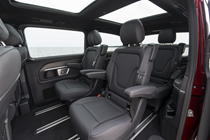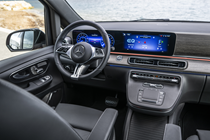
Mercedes-Benz EQV review
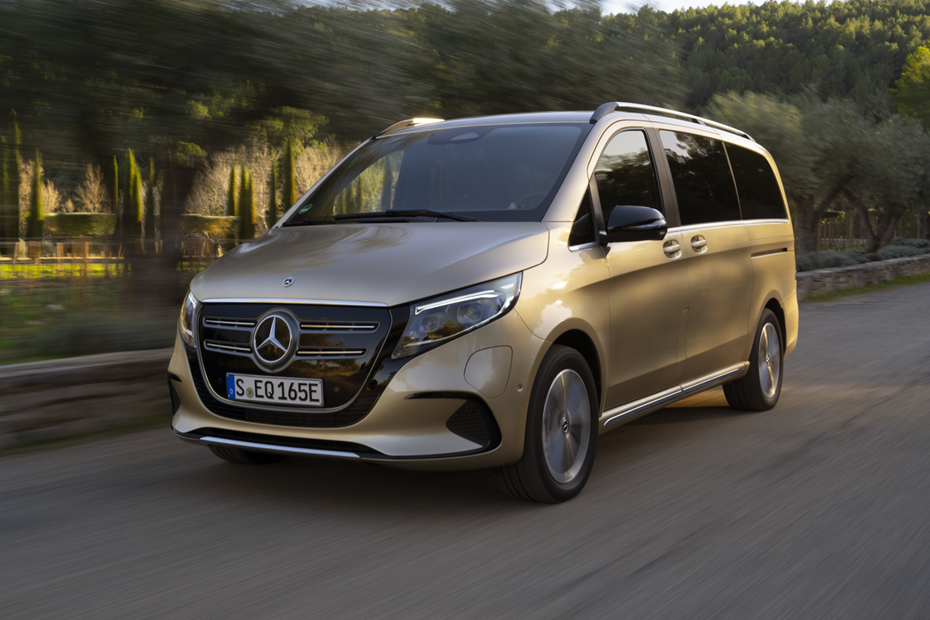
At a glance
| Price new | £87,995 - £96,070 |
|---|---|
| Used prices | £38,060 - £63,393 |
| Road tax cost | £0 |
| Insurance group | 50 |
Get an insurance quote with

|
|
| Fuel economy | 2.1 - 2.3 miles/kWh |
| Range | 211 - 213 miles |
| Miles per pound | 3.3 - 6.8 |
| View full specs for a specific version | |
Available fuel types
Fully electric
Pros & cons
- Huge inside
- Easy to drive and comfortable
- Claimed 213-mile range, 204hp electric motor
- Sluggish performance
- Expensive to buy
- Real-world range nearer 150 miles
Overview
Luxury people carriers are few and far between, but if you want one that’s also electric, you can count the options on one hand. Since it arrived in 2019, the Mercedes-Benz EQV has almost been in a class of its own, supplementing the luxury Multi-Purpose Vehicle market with a battery-powered alternative to the opulent V-Class people carrier. It was already comfortable, nicely trimmed and loaded with tech, but for 2024, Mercedes-Benz has updated the model with a new look, new driver assistance features and an even plusher interior.
To transport seven using electricity, you could buy a Tesla Model X or a Volvo EX90, but these aren’t likely to win you any favours from passengers in the far back as space starts to vanish the further you go.
Alternatively, you could opt for a conventionally shaped MPV like a Peugeot e-Traveller or a Vauxhall Vivaro Life Electric, but they’d look less congruous pulling up to a Vogue after party than they would the formation lap of the Italian Grand Prix.
The EQV is one of the few truly premium offerings in this class, with a top-end price tag of just under £88,000. For that, you get a 204hp motor, a luxurious and adaptable interior plus the refinement of an electric motor. Like the smaller EQA and EQC, it’s based on an existing Mercedes platform, in this case the V-Class MPV.
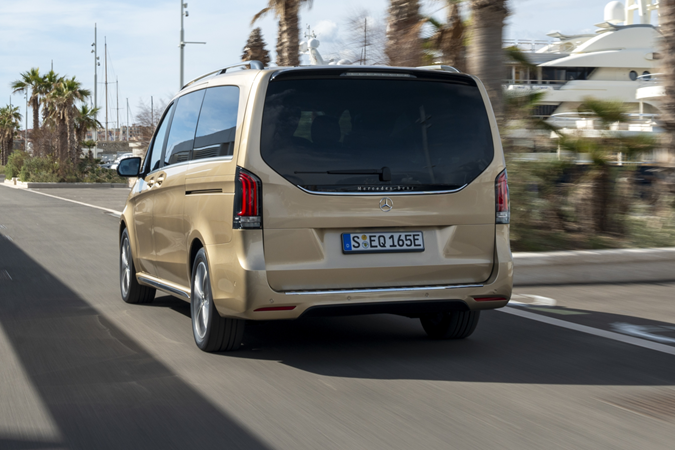
In terms of how it looks, there are no surprises. It looks like a V-Class with something akin to the EQC’s nose grafted to it. For 2024, Mercedes has refreshed the EQV’s front end with a new grille and a refreshed bumper while at the back a chrome strip has been added along with new alloy wheels. Despite a giant battery, the interior is just as spacious with only a few subtle changes giving the game away. Even then, the EQV-specific digital displays are only likely to be seen by the driver.
What is the Mercedes-Benz EQV’s range?
Despite being based on the eVito electric van with a paltry 162-mile range between recharges, a much larger battery means it’s capable of 211-213 miles of range according to WLTP testing. Based on our experiences we’d expect that to be nearer 150 miles in the real world if you venture onto the motorway. Thank a 2.6-tonne kerb weight for that.
The batteries are located under the EQV’s floor, giving it the same versatility as the diesel-engine V-Class. That means all occupants can face forward, or you can configure the rear seats to face each other with a central table. Perfect for those impromptu conferences mid-journey.
What about charging the EQV?
How long it takes to replenish the EQV’s 100kWh battery pack (90kWh usable) depends on where it’s being topped up, but at a rapid public charger it will go from 10% to 80% in 45 minutes.
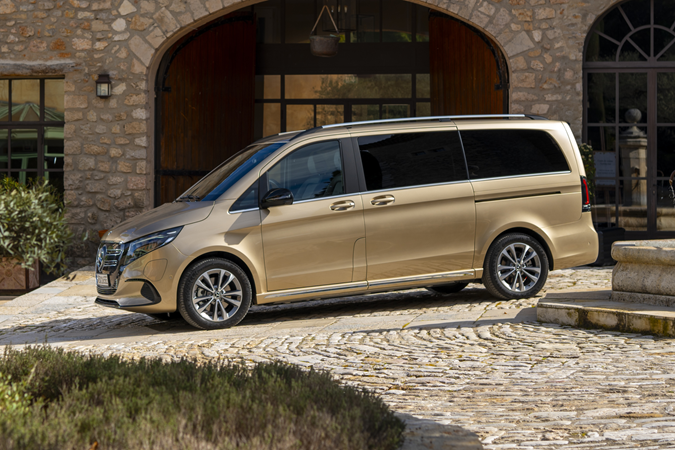
On a domestic wall box that figure expands significantly to 10 hours (Mercedes-Benz quotes a 10% to 100% figure here), which makes this an overnight operation, as is the case with many high-end EVs these days.
All that can be monitored and managed via smartphone, and there’s all the pre-conditioning possibilities, be it warm or cold, to make setting off as comfortable and economical as possible.
What’s the interior like?
The EQV’s dashboard has been refreshed with two 12.3-inch displays, along with new air vents and Mercedes’ latest steering wheel design. It’s adorned with touch-sensitive buttons, though they’re still unfortunately prone to the occasional accidental nudge.
The dashboard itself has all the hallmarks of a Mercedes offering with polished metals and 64 ambient lighting colours to choose from but remains comparatively subdued and focussed for the Mercedes range. Moving to the rear of the cabin, the fit and finish is excellent. There’s plenty of adjustability on offer for the comfortable and supportive rear seats, with ample storage space located around the vehicle.
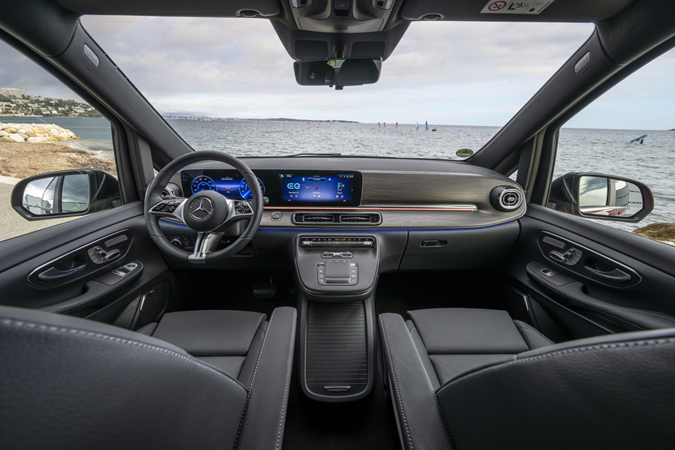
What about driver aids?
Mercedes has introduced additional driving assistance systems to simplify and improve the EQV’s overall driving experience. They include a cross-traffic active brake assist function to warn drivers of oncoming vehicles taking dangerous overtaking manoeuvres, among many others. Despite the vehicle’s size and weight, the driver assistance features make the EQV a relatively simple machine to drive, even for inexperienced van drivers. Owing to great visibility and myriad cameras around the car, it’s easy to stay on top of what’s around you on the road.
What’s it like to drive?
Nestled under the bonnet is a 204hp electric motor that drives the front wheels via a one-speed automatic transmission. The 0-62mph time is claimed at 12.1 seconds and the maximum speed is electronically capped at 99mph. As you’d expect from that time, performance is pretty leisurely even with one person aboard, but it’ll happily haul itself up to 70mph and stay there without fuss.
You can change the strength of the regenerative braking that tops up the battery when you come off the accelerator pedal. In its strongest mode, you rarely have to touch the brake pedal as it slows down quickly when you come fully off the accelerator pedal. Weaker modes will suit those who’d rather slow down using the brake pedal, while auto mode varies the deceleration depending on traffic in front of you. Although this works well in other Mercedes models, we found it led to an inconsistent response to the brake pedal that made smooth driving tricky.
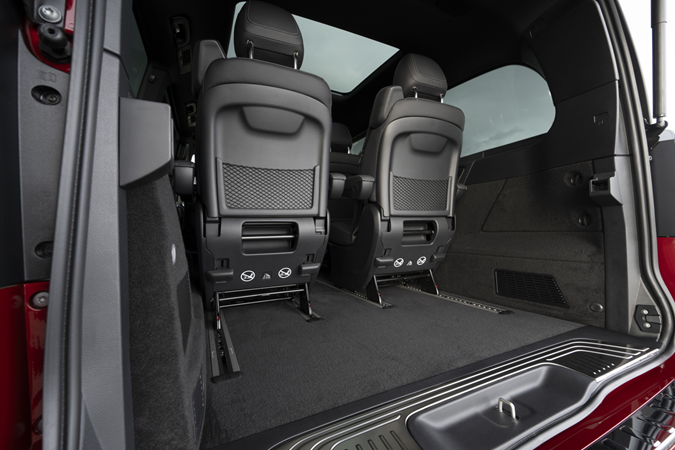
You never get away from the weight and size of the EQV, though. But it’s exactly as you would expect it to be – great visibility from a high driving position gives you confidence in traffic, and it’s stable and quiet on the motorway. We’ve so far only sampled it with the air suspension that comes on the top Sport Premium Plus model. It’s soft and comfortable around town, but you really feel the EQV’s weight at higher speeds with a floaty sensation over crests and compressions.
Unsurprisingly, the squidgy suspension means plenty of body roll in the bends which won’t leave your passengers particularly happy. Even so, there’s sufficient grip to drive it far more briskly than you’d think although it’s anything but agile – no surprise given how weighty it is.
The EQV offers Eco, Comfort and Sport drive modes, and there’s quite a difference between the three. Eco mode encourages slower driving, blunting accelerator response, which makes town driving a bit of a chore. Comfort is a good compromise offering better throttle response while Sport is a bit too sharp for our liking.
What versions are available?
Currently, there’s just one battery-spec available – the EQV 300 – offering the maximum range, and there are three trim levels: Sport, Sport Premium and Sport Premium Plus, maxing out at just over £96,000 in cash terms.
All EQVs get leather seats with Sport Premium adding the table we mentioned above.







